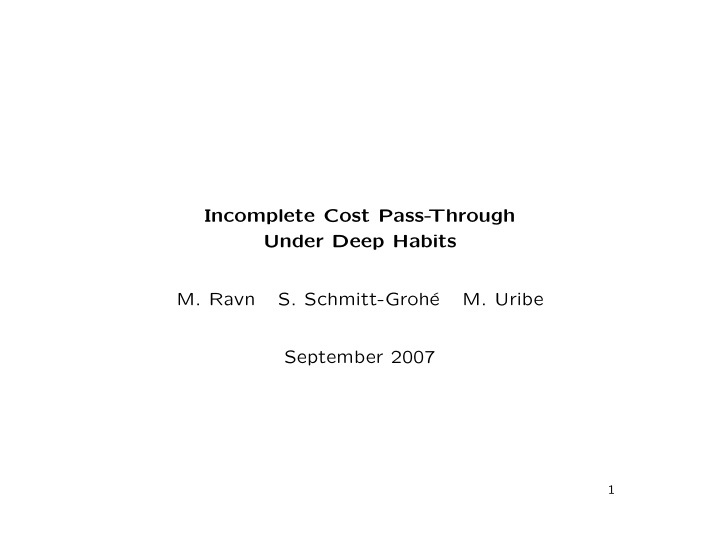



Incomplete Cost Pass- Through Under Deep Habits M. Ravn S. Schmitt-Groh´ e M. Uribe September 2007 1
Stylized Facts We Wish To Address • Innovations in marginal costs are associated with less than proportional increases in prices (incomplete cost pass-through). • Prices are less volatile than marginal costs. • Markup adjustments explain a significant fraction of incomplete cost pass-through. Some Key References: Giovannini ( JIE , 1988), Kadiyali ( JIE 1997), Hellerstein (2006), Goldberg and Campa (2006), Nakamura (2006), Goldberg and Hellerstein (2007). 2
• Observation: Most existing structural estimations of cost pass-through using highly disaggregate data are based on static models. • Limitations of Static Models: – Cannot distinguish between effects of permanent versus transitory cost shocks. – Cannot distinguish between effects of anticipated versus unanticipated cost shocks. • This Paper: Dynamics take center stage. 3
Habit Formation Period Utility Function: U ( x t ) Superficial Habit Formation: Habits are formed at the level of a composite good �� 1 � 1 1 − 1 1 − 1 c t η η x t = with c t = 0 c di it c θ t − 1 Habits are formed at the level of Deep Habit Formation: individual goods 1 1 − 1 1 − 1 � 1 η η c it x t = di c θ 0 it − 1 4
A Model of Incomplete Pass- Through Household j minimizes � 1 0 P it c j it di, subject to 1 / (1 − 1 /η ) 1 − 1 /η � 1 c j ≥ x j it di t c θ 0 it − 1 θ = deep-habit parameter c it − 1 = External habit stock, taken as given by households. 5
Demand for good i by household j � � − η P it c θ (1 − η ) c j x j it = t , it − 1 P t • Short-Run Price Elasticty = η η • Long-Run Price Elasticty = 1 − θ (1 − η ) > η • Habit elasticity θ (1 − η ) 6
The Firm • Maximize present value of expected profits � ∞ β t E 0 ( P it − MC it ) c it , t =0 subject to it c θ (1 − η ) c it = A t P − η it − 1 • pricing problem of the firm becomes dynamic • First-order condition: � � 1 − 1 + βθ 1 − η c it +1 = MC it P it E t P it +1 η η c it 7
The Markup • Define the markup as P it µ it ≡ MC it Then, the firm’s FOC implies 1 µ it = � � � � P it +1 c it +1 1 − 1 1 − βθE t η P it c it • The markup is time varying. • The markup is decreasing in the expected growth of sales. 8
• Steady state markup � � � � 1 η η µ = < ( η − 1) . η − 1 1 − βθ
A Law of Motion for Marginal Costs MC it +1 = λ � � MC it + ǫ t +1 Calibration of the Model Parameter Value 0.99 β 6 η 0 λ -0.1 θ 9
Impulse Response to a One-Percent Increase in Marginal Cost period price marg.costs markup 0 0.81 1 -0.19 1 -0.11 0 -0.11 2 -0.04 0 -0.04 3 -0.01 0 -0.01 4 -0.01 0 -0.01 Units: percent deviations from the steady state. ⇒ Incomplete Cost Pass-Through 10
Price-Cost Volatility Ratio var ( P it ) var ( MC it ) = 0 . 66 ⇒ Prices are less volatile than marginal cost 11
Persistence of Cost Shocks and Incomplete Pass- Through 0.2 0.15 0.1 log( µ t / µ ss ) 0.05 0 −0.05 −0.1 −0.15 −0.2 0 0.1 0.2 0.3 0.4 0.5 0.6 0.7 0.8 0.9 λ ⇒ Pass-through increases with the persistence of marginal cost shocks. 12
Persistence of Cost Shocks and the Volatility of the Price-Cost Ratio 1 0.95 0.9 σ P / σ MC 0.85 0.8 0.75 0.7 0.65 0 0.1 0.2 0.3 0.4 0.5 0.6 0.7 0.8 0.9 λ ⇒ Prices remain less volatile than costs even for highly persistent cost shocks. 13
Anticipated Marginal-Cost Shocks period price marg.costs markup 0 0.29 0 0.29 1 0.77 1 -0.23 2 -0.12 0 -0.12 3 -0.05 0 -0.05 4 -0.02 0 -0.02 Units: percent deviations from the steady state. ⇒ About 1/3 of the future expected increase in costs is passed onto prices upon arrival of information. Consequently, a smaller fraction of the cost shock is passed onto prices upon realization of the shock ⇒ Measured pass-through is more incomplete. 14
Conclusions • Deep habit formation gives rise to a theory of time-varying markups. • The markup is a decreasing function of expected revenue growth. • Deep habit formation induces incomplete pass-through of marginal cost shocks. • Incomplete pass-through is more severe the more transitory the cost shocks are. • Anticipation of cost shocks exacerbates the incompleteness of cost pass- through. 15
Recommend
More recommend